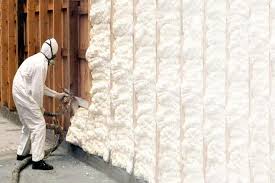Looking to reduce noise transmitting through walls, ceilings, and floors in your home? Upgrading with spray foam insulation is an effective sound-dampening solution. Properly installed spray foam dampens airborne noise and helps create a quieter interior living space. Understanding the acoustic qualities of spray foam insulation sound reduction and best practices for installation will ensure excellent noise-blocking results.
The Science of Noise Reduction
To fully grasp how spray foam insulation achieves its impressive sound-dampening and audio transmission-blocking abilities, let’s dive into some of the science around noise control.
How Insulation Affects Sound Transmission
First, it’s important to understand how sound energy actually transmits from its source throughout a building. Sound generates waves of vibrations that travel through both the air and the physical materials making up the structure.
Good spray foam sound insulation works to block and absorb these sound wave energy vibrations rather than letting them pass through walls, floors, and ceilings to adjacent spaces. The properties of the insulation material, along with proper installation, are key factors.
How Spray Foam Blocks Noise
Spray foam insulation comprises advanced cellular materials specially formulated to obstruct sound waves. The complex microscopic structure both dampens vibrations and restricts passage.
By filling every crevice and gap, spray foam eliminates open-air passages that would allow sound to transmit freely. This airtight property maximizes noise blocking.
The Science Behind Noise Reduction
Spray foam leverages scientific principles like wave conversion, diffraction, reflection, and absorption to effectively minimize noise. Understanding the science reinforces why spray foam insulation is uniquely equipped for superior sound deadening compared to alternatives.
With both fundamental concepts and spray foam’s structural advantages covered, its noise reduction capabilities become clear.
Advantages of Spray Foam Insulation
Among insulation options, spray polyurethane foam provides ideal properties for controlling sound:
- Open-cell foam with small air pockets
- Expands and seals gaps, cracks, and spaces
- Excellent noise absorption from dense structure
- Rigid foam won’t settle or degrade over time
For homeowners, these advantages make spray foam a preferred sound-dampening insulation.
How Does Spray Foam Insulation Provide Reduce Noise?
Spray foam insulation leverages a combination of unique physical properties and structural effects to dampen, absorb, and block noise transmission through walls, ceilings, floors, and other building separations.
The Multi-Faceted Acoustical Properties of Spray Foam
Spray foam insulation achieves its impressive sound-deadening capabilities through several synergistic mechanisms:
- Intricate cellular structure: Open-cell spray foam contains billions of tiny air bubbles in an intricate matrix. This complex microstructure effectively dissipates and attenuates sound wave energy as it passes through the foam. It dampens a broad spectrum of audio frequencies.
- Absorption of vibrational energy: The dense foam matrix physically absorbs sound wave energy instead of reflecting it. As sound travels through the foam, the vibrational energy gets converted into small amounts of heat energy and dissipated rather than being transmitted through the structure.
- Rigid insulation: Spray foam cures into a rigid plastic matrix that does not compress or move. This prevents sound vibrations from passing easily through the foam, containing the waves within the foam structure.
- Air sealing: Foam adheres tightly to surfaces and seals gaps, cracks, and holes. This air tightness prevents airborne noise from traveling between rooms or escaping outside. Stopping air leaks is crucial for effective sound dampening.
By leveraging absorption, conversion, rigid insulation, and comprehensive air sealing, spray foam insulation provides complete, multifaceted noise reduction. Rather than simply muffling sound, it targets all aspects of noise transmission in a building. This makes spray foam one of the most effective options available for noise reduction.
Comparing Spray Foam Insulation to Traditional Sound-deadening Methods
We’ve learned that spray foam insulation is an effective way to reduce noise. But how does spray foam insulation compare against traditional sound reduction techniques like caulk, insulation batts, drywall, and noise-reducing constructs?
Efficacy in Noise Reduction
Spray foam insulation often provides better noise reduction than piecemeal sound-dampening products and materials. With full coverage and gap filling, spray foam outperforms most DIY methods.
Only specialized acoustical caulk and multi-layer damping constructs can potentially exceed spray foam’s sound-blocking capacities in certain applications. However, these methods are often far more complex and costly to implement. For straightforward, affordable, and effective sound deadening, spray foam is hard to beat.
Installation Convenience and Efficiency
Spraying foam insulation provides a simpler installation process than meticulously sealing edges and assembling numerous noise barriers.
With spray equipment used by professional installers, an entire floor or wall cavity can be insulated and sound-deadened seamlessly. No cutting pieces to size or sealing individual cracks and openings. The ease and speed of installing spray foam is a major advantage over fiddly acoustic materials.
Professional vs. DIY Installations
Installing spray foam insulation may seem straightforward, but the proper application requires nuanced skills, extensive training, and specialized equipment to achieve optimal insulation value, full and even coverage, and long-term performance. DIY spray foam kits rarely deliver reliable, consistent results.
Why You Should Choose Professional Spray Foam Installers
While the concept of spraying foam insulation is simple, the actual process requires proficiency to maximize effectiveness and avoid potential issues. Professional spray foam insulation contractors offer critical advantages over DIY kits:
- Proper spray techniques: Professional installers are trained in proper spraying motion, distance, angle, and overlap to achieve seamless, gap-free coverage across the full area. Their technique ensures even foam depth and density.
- Knowledge of optimal foam thicknesses: Contractors are familiar with the recommended foam thickness per application to provide proper R-values while avoiding excess material use. They determine the correct foam type and thickness to meet building code requirements.
- Specialized spray equipment: Insulation contractors use top-of-the-line, high-volume spray rigs for greater efficiency. Their rigs are also specially calibrated to apply the foam with precision. They have access to extension poles and lifts to reach high areas.
- Training in safe chemical handling: Professional installers complete training on properly handling spray foam chemicals, wearing personal protective equipment, and controlling fumes and ventilation during application. They know how to prevent overexposure or accidents.
- Certifications: Leading foam contractors carry certifications showing they are properly trained and experienced in installation best practices. DIY kits don’t require any training or certification.
When done properly, spray foam insulation provides superior air sealing, insulation value, and longevity. Unless you plan to invest substantially in equipment, training, and certifications, professional installation is strongly recommended over DIY kits. Qualified contractors deliver reliable, high-quality spray foam applications the first time.
Conclusion: Is Spray Foam Insulation Right for Your Noise Reduction Needs?
Determining if spray foam is the right solution depends on evaluating your specific home, budget, and noise situation.
Reviewing the Advantages
The main benefits of using spray foam insulation for sound reduction are:
- Effective noise reduction across frequency ranges
- Fills and seals all gaps thoroughly
- Long lasting over decades
- Simpler installation than many acoustic materials
Evaluating the Investment
Pricing for upgrading walls, floors, or ceilings with spray foam insulation will vary depending on the scope of work. Spray foam provides both sound-deadening and thermal insulation benefits. For homeowners needing to reduce noise transmission through their living spaces, this investment in spray foam insulation typically delivers satisfying acoustic control and energy savings.
Consulting with professional insulation contractors is the best way to determine if spray foam is right for your particular sound-dampening project. But for many circumstances, spray foam provides a high-performance and cost-effective noise solution.
Trust Cincinnati RetroFoam for Foam Insulation
When it comes to foam insulation in Cincinnati homes and buildings, there’s one company you can trust – Cincinnati RetroFoam.
As a local company rooted in Cincinnati, we understand our climate, older housing stock, and the benefits foam insulation offers. We provide top-quality foam insulation solutions for any project. From start to finish, you can rely on our team of seasoned professionals to implement your foam insulation right. We take care of assessing your existing insulation, determining ideal spray points, installing the foam throughout cavities, and neatly patching all cavities.
If you’re looking to upgrade your home’s insulation, look no further than the experts at Cincinnati RetroFoam. Our tailored solutions, outstanding service, and results you can count on make us the smart choice for foam insulation.
FAQs
How much does spray foam reduce sound?
Spray foam insulation can significantly reduce sound transmission through walls, ceilings, and floors. By filling in gaps and sealing cracks, spray foam minimizes areas where sound can penetrate. It also adds mass and damping which helps block sound vibrations. Exact noise reduction will depend on the type of spray foam used and application thickness.
Does spray foam create a sound barrier?
Spray foam insulation can help reduce sound transmission when installed properly. The dense cellular structure of spray foam minimizes air infiltration and seals cracks and gaps in walls, floors, and ceilings. This sealing effect helps block noise from traveling through the building structure.


